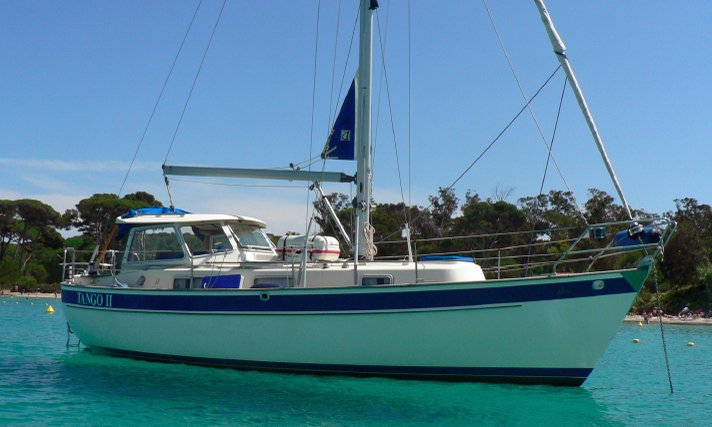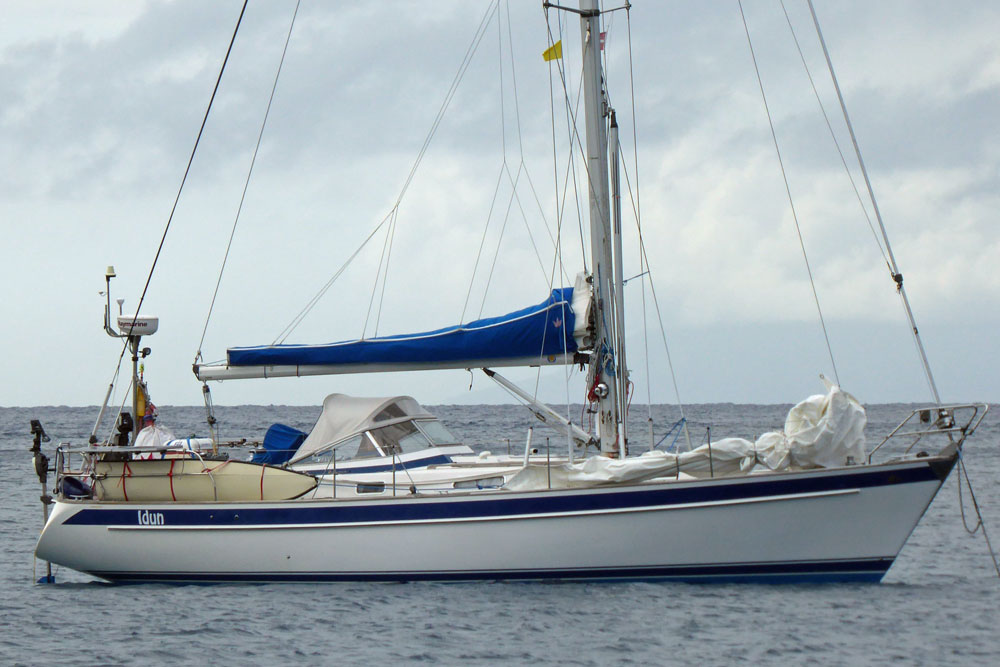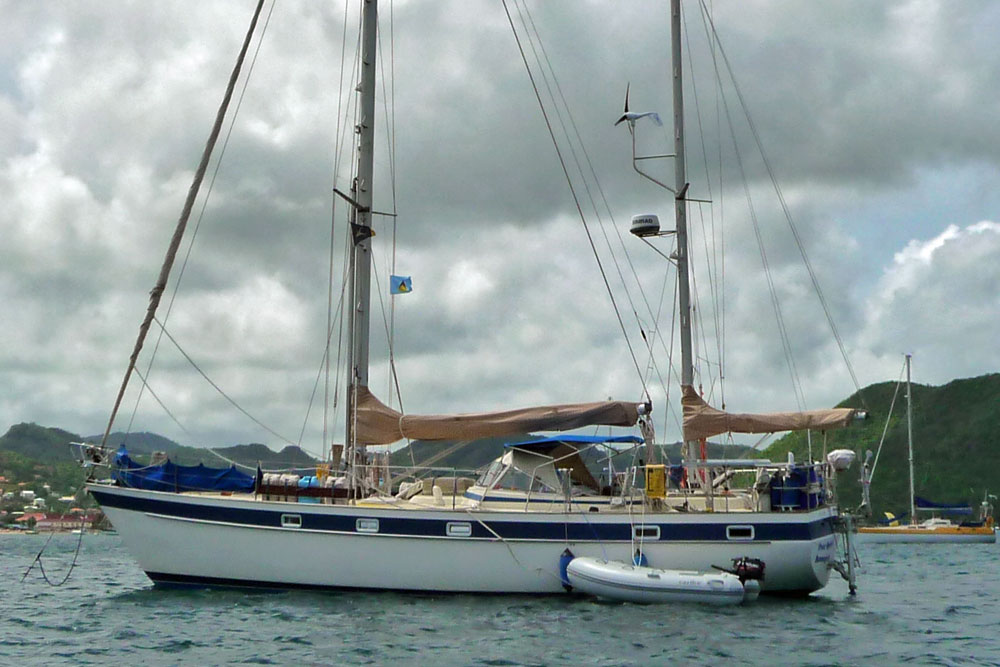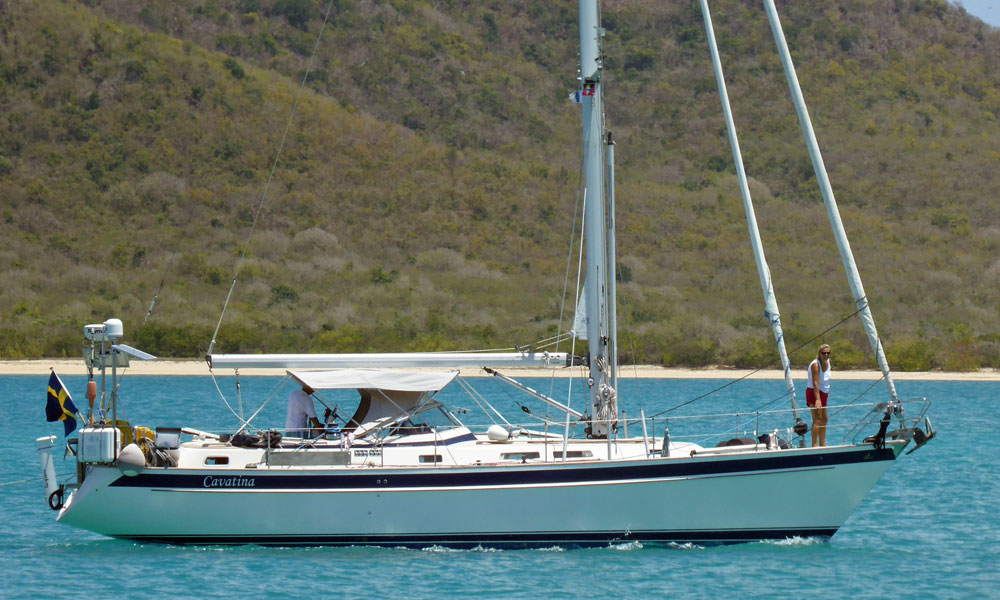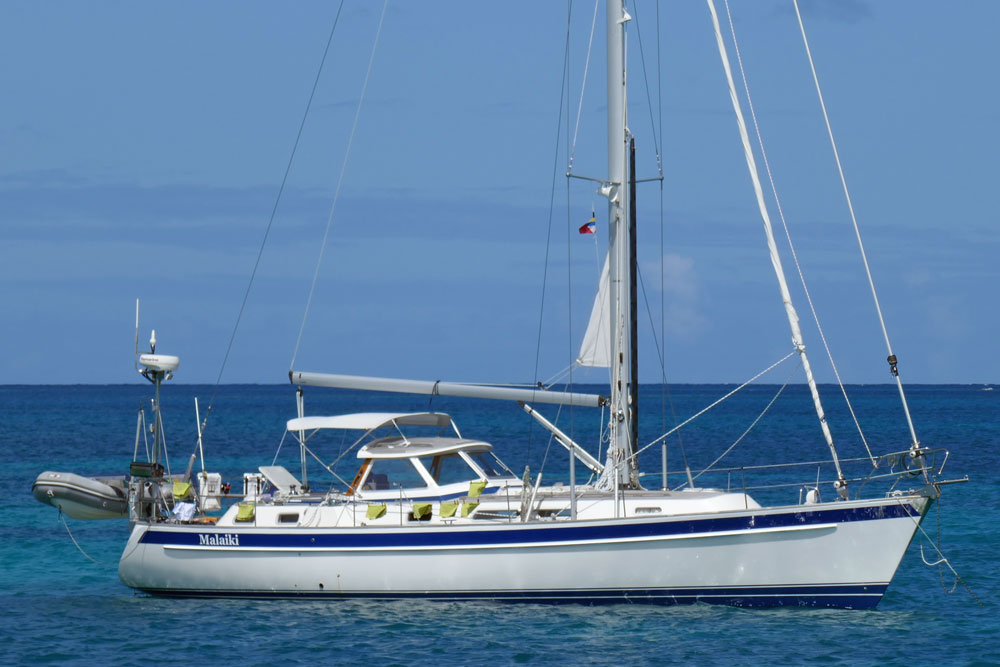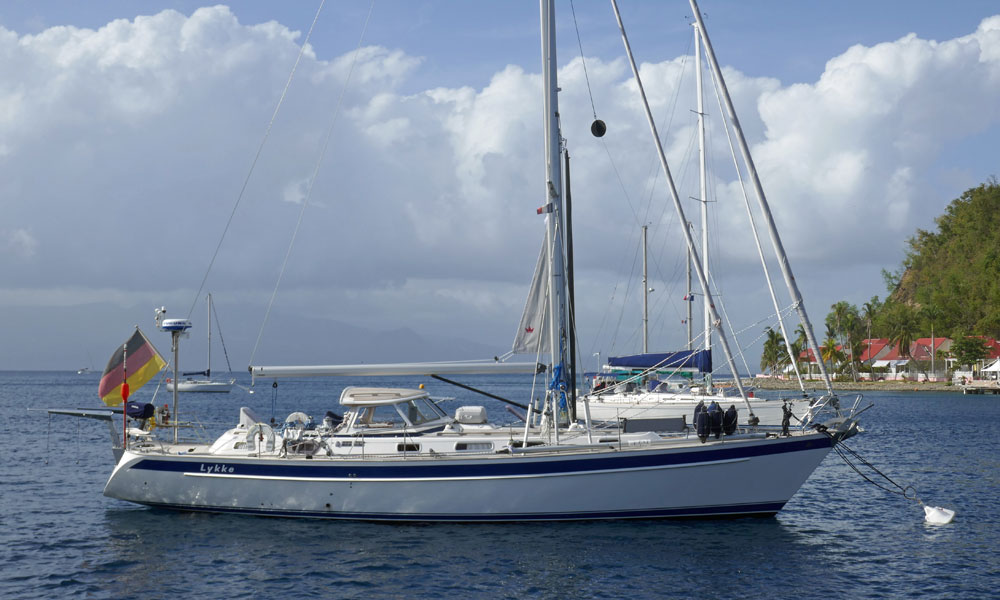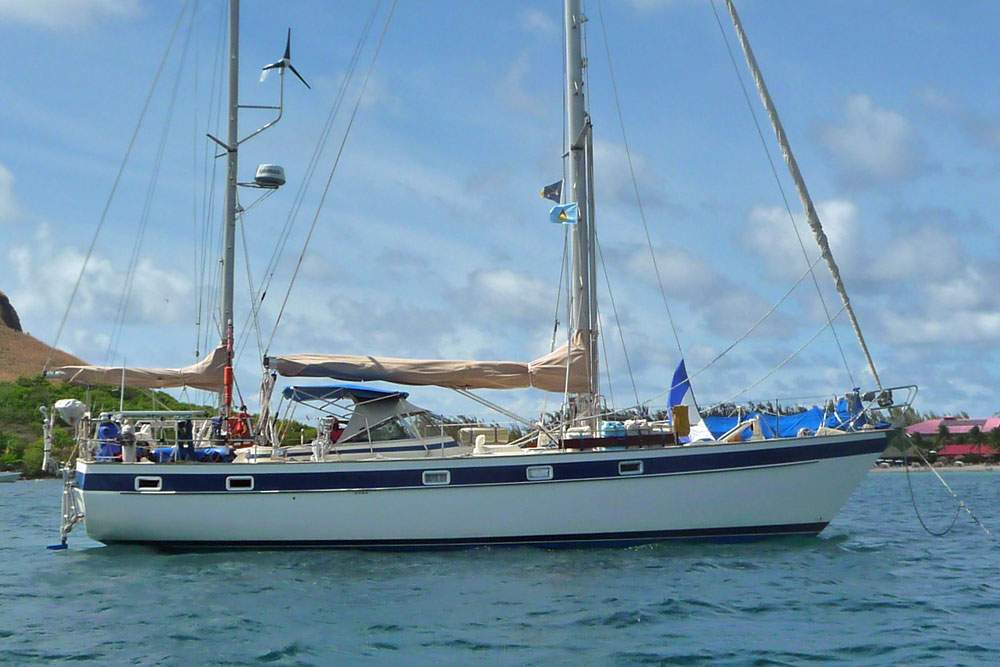- Home
- Cruising Yachts 45' to 50'
- Hallberg-Rassy 48
The Hallberg-Rassy 48 Sailboat
Specs & Key Performance Indicators
The Hallberg-Rassy 48, a centre-cockpit cutter, was designed by Germán Frers and built in Sweden by Hallberg-Rassy.
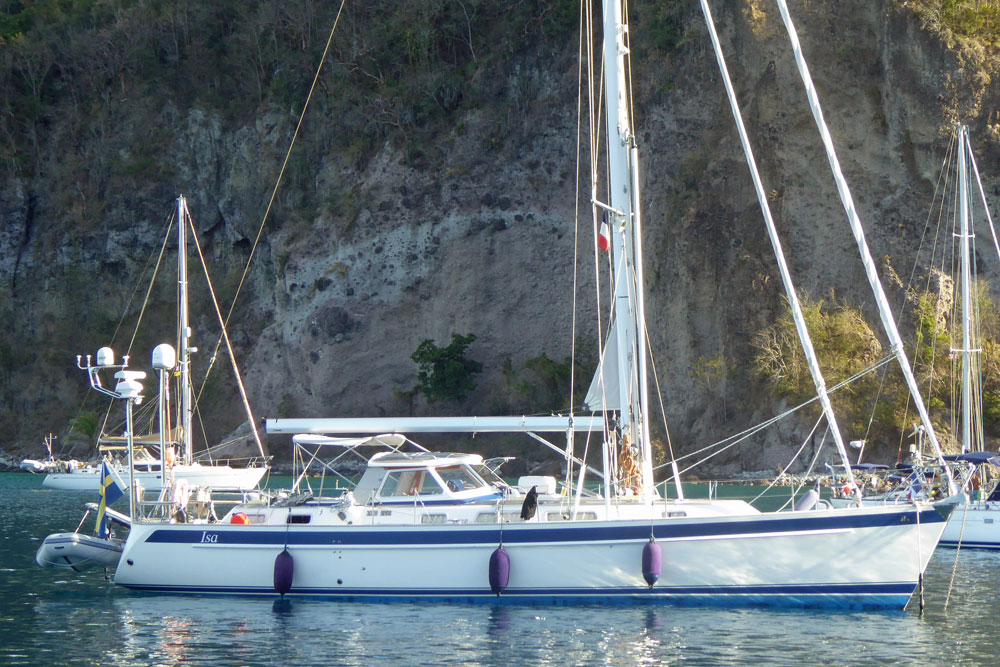 A Hallberg-Rassy 48
A Hallberg-Rassy 48Published Specification for the Hallberg-Rassy 48
Underwater Profile: Fin keel & half-skeg rudder
Hull Material: GRP (Fibreglass)
Length Overall: 49'2" (15.0m)
Waterline Length: 43'6" (13.3m)
Beam: 14'9" (4.5m)
Draft: 7'9" (2.4m)*
Rig Type: Cutter**
Displacement: 40,786lb (18,500kg)
Designer: Germán Frers
Builder: Hallberg-Rassy (Sweden)
Year First Built: 2004
Year Last Built: 2013
Number Built: 69
* A shoal draft version was also produced drawing 6'6" (2.0m)
** A masthead sloop version was also produced
Published Design Ratios for the Hallberg-Rassy 48
1. Sail Area/Displacement Ratio: 18.0
2. Ballast/Displacement Ratio: 41.9
3. Displacement/Length Ratio: 222
4. Comfort Ratio: 38.7
5. Capsize Screening Formula: 1.7
Performance Expectations, Based on the Design Ratios
The Hallberg-Rassy 48 is a modern cruiser with a moderate displacement of 36,700 lb and a generous sail area of 1,203 sq ft.
- The sail area to displacement ratio (SA/D) is 18.0, which indicates that the boat has enough power to sail well in light to moderate winds.
- The ballast to displacement ratio (B/D) is 42%, which means that the boat has a low centre of gravity and a high stability.
- The displacement to length ratio (D/L) is 222, which places the boat in the medium range of hull forms. The boat is neither too heavy nor too light, and can handle various sea conditions with ease.
The boat has a fin keel with a bulb and a spade rudder, which provide good manoeuvrability and responsiveness. The boat also has a powerful 110-hp Volvo engine with a folding propeller, which can push the boat at over 8 knots under power. The fuel tank capacity is 212 gal, which gives the boat a long range of over 1,000 nautical miles.
Production Period and Numbers Produced
The Hallberg-Rassy 48 was introduced in 2004 as a successor to the popular Hallberg-Rassy 46. The boat was improved on several aspects, such as a longer waterline, a wider aft cabin, larger windows, and more sail area. The boat was produced until 2013, when it was replaced by the Hallberg-Rassy 48 Mk II, which had further enhancements such as frameless windows, more natural light, more ventilation, and a new design for the windscreen and pushpits. The total number of Hallberg-Rassy 48s built was 69, while the number of Hallberg-Rassy 48 Mk IIs built so far is 29.
Alternative Versions & Options
The Hallberg-Rassy 48 offers some choices for the layout and equipment of the boat. The standard layout has three cabins and two heads, with a large owner's cabin aft with an ensuite head and shower. The forward cabin has a V-berth and access to the second head and shower. The third cabin has upper and lower bunks on the starboard side. Alternatively, the owner's cabin can have two single berths on each side or a king-size berth on the centerline with seats on each side. The forward cabin can also have an optional Pullman berth above the V-berth.
The galley can be either linear on the port side or U-shaped on the starboard side. The saloon can have either armchairs or a sofa on the port side. The navigation station can be either forward-facing or aft-facing.
Number & Location of Sleeping Berths
The Hallberg-Rassy 48 can sleep up to eight people in three cabins and the saloon. The owner's cabin aft has either two single berths on each side or one king-size berth on the centerline with seats on each side. The forward cabin has a V-berth that can be converted into a double berth with an infill cushion. There is also an optional Pullman berth above the V-berth. The third cabin has upper and lower bunks on the starboard side. The saloon can have either armchairs or a sofa on the port side that can be converted into a single berth with an infill cushion.
Press Reviews
The Hallberg-Rassy 48 has received positive reviews from various sailing magazines and websites. Here are some excerpts from some of them:
- "Comfortable with the success of their Hallberg-Rassy 46 and conservative by nature, the design team of Germán Frers and Hallberg-Rassy approached the creation of its successor, the Hallberg-Rassy 48, cautiously... Despite its 20-ton displacement, I found the boat quick and responsive even in light air... The fit and finish of the plush interior is of the highest standard available today."
- "Although based on the same concept as the German Frers–designed 46-foot bluewater cruiser that this Swedish builder has produced for many years, the HR 48 has an entirely new hull and layout. Interior space has been expanded with a longer waterline and has been brightened with larger side windows... The HR 48 is a solid, well-built boat that will take you anywhere in comfort and style."
- "The Hallberg-Rassy 48 sets a higher standard regarding quality and finest workmanship within the segment for bigger cruisers. The yacht is not only beautiful to look at and easy to sail. It also offers easy handling on the oceans.”
Owner Testimonials
The Hallberg-Rassy 48 has many satisfied owners who have shared their experiences and opinions about the boat on various forums and blogs. Here are some examples of what they have said:
- "We have sailed our HR 48 for six years now and we are very happy with her. She is fast, comfortable, safe, and beautiful. We have crossed the Atlantic twice, sailed in the Caribbean, the Mediterranean, and the Baltic. She handles all kinds of weather and sea conditions with grace and stability. She is also easy to sail short-handed, thanks to the electric winches, furling sails, and bow thruster. We love our boat and we would not change her for anything."
- "We bought our HR 48 in 2007 and we have sailed her around the world. She is a fantastic boat that has never let us down. She is spacious, well-equipped, and well-maintained. She sails well in light winds and heavy seas. She is also very comfortable to live aboard, with plenty of storage, ventilation, and amenities. She is a dream come true for us and we are very proud of her."
- "We have owned our HR 48 since 2010 and we have sailed her extensively in Europe and North America. She is a superb boat that combines performance, comfort, and quality. She is easy to handle, even for a couple, and she has a lot of character and charm. She is also very reliable and durable, with no major issues or problems. She is a joy to sail and to own."
History of the Boatbuilder
Hallberg-Rassy is one of the most respected boatbuilders in the world, with a long history of producing high-quality bluewater cruising yachts. The company was founded in 1943 by Harry Hallberg, who started his career as a wooden boatbuilder in Sweden. In 1963, he switched to GRP boats and became one of the pioneers in serial production of sailboats using this material. He was also the first to successfully combine GRP hulls with wooden superstructures.
In 1972, Harry Hallberg retired and sold his yard to Christoph Rassy, a German boatbuilder who had moved to Sweden in 1960. Christoph Rassy had also started his own yard in 1965, building wooden boats at first, then switching to GRP boats in 1971. He had also collaborated with Harry Hallberg on some projects before buying his yard.
The two yards merged under the name Hallberg-Rassy, and continued to produce high-quality cruising yachts that combined traditional craftsmanship with modern technology. The company hired Germán Frers as their main designer in 1989, who brought a new level of performance and elegance to their boats.
Today, Hallberg-Rassy is still owned by the Rassy family, with Christoph's son Magnus Rassy as the CEO. The company has built over 9,400 yachts since its inception, ranging from 24 to 64 feet in length. The company has won many awards and accolades for its boats, such as European Yacht of the Year, Hiswa Yacht of the Year, Sailboat of the Show, etc.
Secondhand Values
The Hallberg-Rassy 48 is a highly sought-after boat on the secondhand market, due to its reputation for quality, durability, and resale value. The price of a used Hallberg-Rassy 48 depends on several factors, such as the year of production, the condition of the boat, the equipment level, the location of the boat, etc.
According to some online sources, the average price of a used Hallberg-Rassy 48 ranges from around £400,000 to £800,000 GBP (or from around $550,000 to $1,1000 USD). The older models (from 2004 to 2013) tend to be cheaper than the newer models (from 2014 onwards), but they may also require more maintenance or upgrades.
This article was written with the assistance of Gemini, a large language model developed by Google. Gemini was used to gather information, summarize research findings, and provide suggestions for the content and structure of the article.
Other sailboats in the Hallberg-Rassy range include:
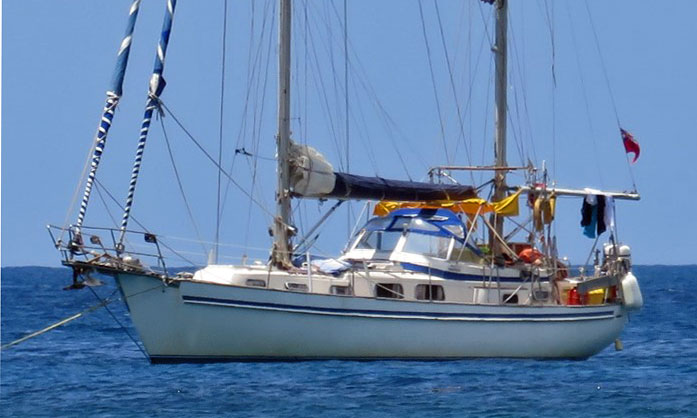 The Hallberg-Rassy 41
The Hallberg-Rassy 41Recent Articles
-
Modern Boat Electronics and the Latest Marine Instruments
Dec 20, 25 05:27 PM
Should sailboat instruments be linked to the latest boat electronics as a fully integrated system, or is it best to leave them as independent units? -
Hans Christian 43: Classic Bluewater Cruiser & Liveaboard Sailboat
Dec 10, 25 04:37 AM
Explore the Hans Christian 43: a legendary heavy-displacement, long-keel sailboat. Read our in-depth review of its specs, design ratios, and suitability for offshore cruising and living aboard. -
Planning Your Sailboat Liveaboard Lifestyle: An Ocean Sailor's Guide
Dec 06, 25 05:18 AM
Seasoned sailors share their methodical risk analysis for planning a secure Sailboat Liveaboard Lifestyle, covering financial, property, and relationship risks.
